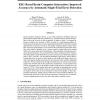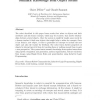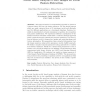66 search results - page 10 / 14 » Intent Recognition for Human-Robot Interaction |
NIPS
2007
13 years 10 months ago
2007
Brain-computer interfaces (BCIs), as any other interaction modality based on physiological signals and body channels (e.g., muscular activity, speech and gestures), are prone to e...
RAS
2008
13 years 8 months ago
2008
The robot described in this paper learns words that relate to objects and their attributes and also learns concepts, which may be recursive, that involve relationships between sev...
MM
2006
ACM
14 years 2 months ago
2006
ACM
We used human movement as the basis for designing a collaborative aesthetic design environment. Our intention was to promote social interaction and creative expression. We employe...
CAIP
2009
Springer
14 years 3 months ago
2009
Springer
This paper describes a comprehensive approach to extract a common feature set from the image sequences. We use simple features which are easily extracted from a 3D wireframe model ...
HAPTICS
2002
IEEE
14 years 1 months ago
2002
IEEE
We present the results of using Hidden Markov Models (HMMs) for automatic segmentation and recognition of user motions. Previous work on recognition of user intent with man/machin...



